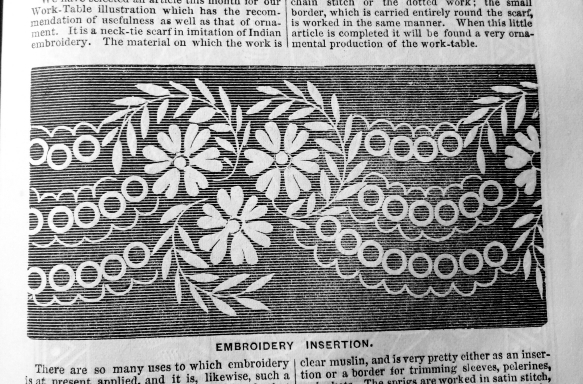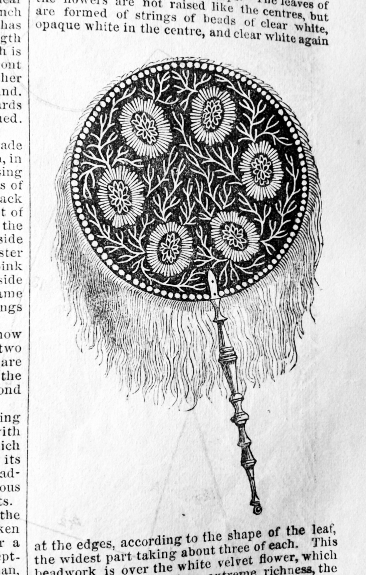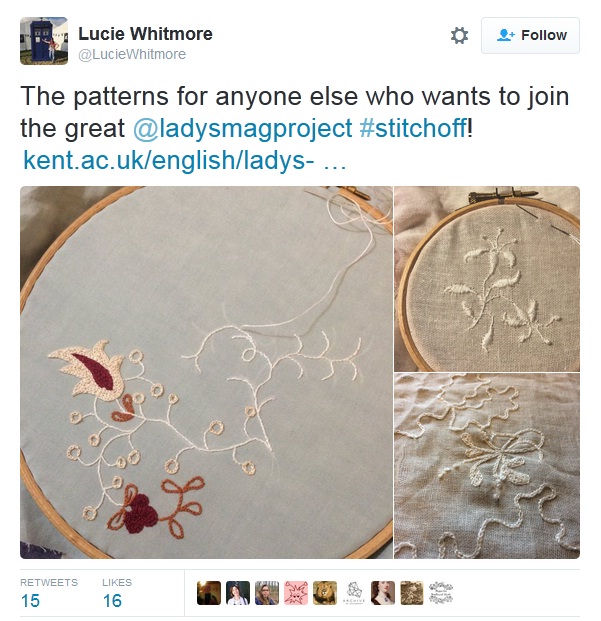
“Neck-tie scarf in imitation of Indian embroidery,” from The Englishwoman’s Domestic Magazine (1860?)
“We are very busy making Edward’s shirts, and I am proud to say that I am the neatest worker of the party.” ~ Jane Austen to her sister Cassandra, 1 Sept. 1796
Needlework was an essential skill for women of all classes during the Regency period, even though upper-class women would have spent more time on decorative work than on what was known as “plain sewing.” But as Jane Austen’s letter to her sister shows, even women of the gentry would have made their husbands’ and brothers’ shirts as well as their own shifts themselves. They would have also known how to mend clothes and how to make alterations.
Plain sewing was typically done in the morning before people would pay their morning calls. It was considered bad etiquette to do plain sewing in the company of visitors (unless they were close family). Instead, for such occasions, decorative needlework like embroidery was deemed suitable. Projects like embroidered shawls or slippers would also be made as gifts for friends and relatives.
Given the high presence of needlework in a woman’s life, it is perhaps not surprising that a lot of magazines targeted at women would include patterns — mostly decorative patterns in the early ladies’ magazines as they were targeted at an upper-class audience. Later, in the mid-19th century when the audience shifted to include middle-class women, several magazines also ran larger patterns for plain sewing.
Patterns (and sheet music) included in periodicals were meant to be used, and for that reason some periodicals like The Lady’s Magazine (launched in 1770) printed them on fold outs. This was good news for the first readers of those magazines — but really bad news for us today because many of those fold outs were indeed cut out and thus are lost to us.
This morning I stumbled across a project at the University of Kent, where three scholars study The Lady’s Magazine. When one of them, Jennie Batchelor, acquired a copy of the 1776 edition of the magazine with almost all of the fold-outs still intact, a new side project was born: The Great Lady’s Magazine Stitch-Off. They are uploading the patterns from the magazine on their website and are inviting people to use them for their own stitching projects and share pictures later on.
Isn’t this fascinating? I think it’s a wonderful way to bring those old patterns back to life.
What about you? Do you enjoy needlework? Would you love to be able to make your own clothes? (That’s on my To Do list for the future , so far I’ve only managed a few embroidery projects as well as a few softies.)



Interesting article. I’m looking at tablecloths. Have you come across any instructions or patterns for these?
Thank you, Cate! I’m afraid I haven’t noticed any patterns for tablecloths, though you could probably adjust a pattern for a scarf or – depending on the size of the tablecloth – use patterns for handkerchiefs for the corners.
My mother made our clothes when we were little, and as a teenager I used to make dresses and skirts. All were made using a sewing machine, albeit hand-turned, I hasten to add! I can hand-sew through, and generally hand-stitched hems and tricky facings, etc.. But as clothes became cheaper to buy, with a wider and better range available, it became undesirable and uneconomic to make my own clothes given the price of fabrics.
I can also embroider, but it’s years since I did. Knitting too — I have knitted cardigans and jumpers, but again wool is so expensive now that it is usually cheaper to buy ready-made.
Here in Germany fabric stores have all but vanished, so it has become rather difficult to get good (and not too expensive!) fabric. Same with wool. I learnt knitting at school, but I’ve never been very good at it. I remember that one of my school projects was a knitted teddy bear, and another time, I spent the Christmas holidays in Austria trying to knit socks. Luckily, the owner of the B&B where we were staying was a terrific knitter and could show me how the heels were done.
Fabric stores are also difficult to find in England now, too.
I’m not what you might call “naturally domestic” –I need great incentive (like a dinner party or a needed new costume) to get me to cook or sew. I can, but just prefer to spend my time on other things. But I have friends who are terrific needleworkers, and you can be sure I am about to share this post with them, Sandy!! Very interesting, and great pictures!
Thank you, Gail! The two patterns are from one of my own copies of The Englishwoman’s Domestic Magazine (but you probably guessed that 🙂 ).
For the past years, I haven’t really had the time nor the leisure for big sewing projects – but that didn’t keep me from buying clothes patterns! LOL! One day, I *will* tackle those bigger projects. I love the various retro patterns that have become available in recent years.
I would love to be able to sew properly. I made dolls clothes for the kids when they were small but that would be the extent of my stitching. But I love to knit and crochet. I dress fashion dolls for my daughter still and I’ve made a few hats and scarves and an odd top. It’s a great pastime but I haven’t had a lot of free time for it for a while.
Lovely! I could not imagine having the time and patience to embroider a whole gown!! I’ll keep my embroidery smaller accessories that don’t get as much abuse!
I do enjoy embroidery–haven’t done it in a while but now I want to! Making my own clothes isn’t something I particularly long to do, though. I tried a little when I was younger but was not (at least at the time) good at getting things to fit properly as a talented seamstress can do. Of course, shopping for clothes is also an “adventure”, as in having to try lots of jeans before finding a pair that works. 🙂
[…] A Stitch (or Two or Three) through Time “We are very busy making Edward’s shirts, and I am proud to say that I am the neatest worker of the party.” ~ Jane Austen to her sister Cassandra, 1 Sept. 1796 Needlework was an essential skill for women of … Continue reading → […]
[…] thought for today’s post, I’d elaborate a little on my February post about needlework, and talk about the social aspects of needlework. As any crafter knows, there is an immense […]